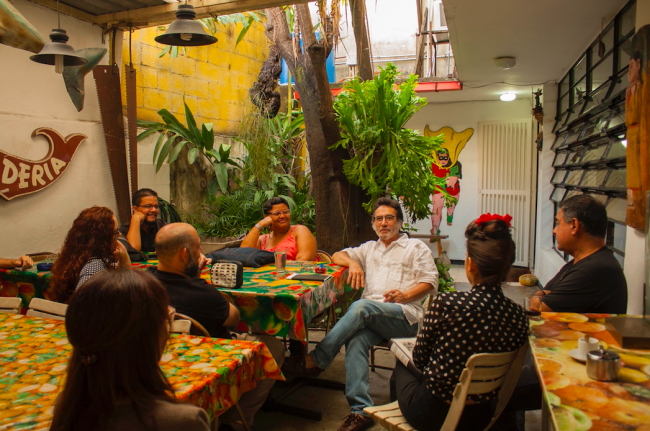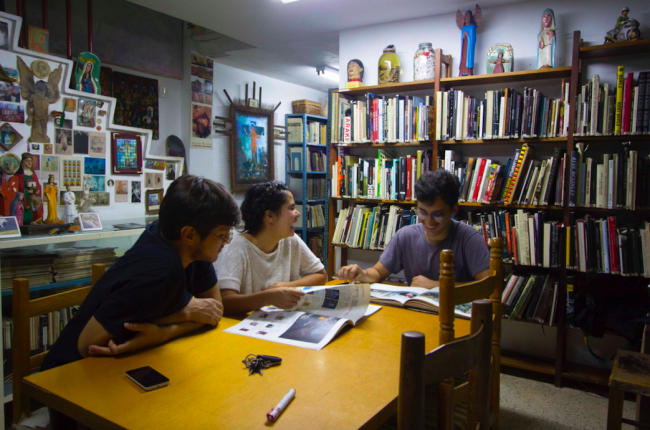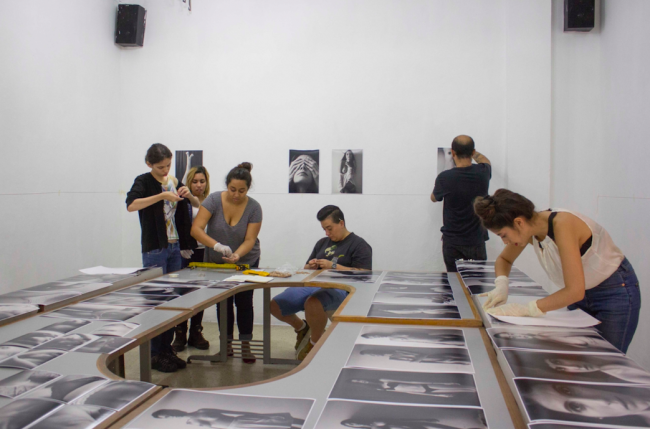
This piece is part of our Spring 2022 issue of the NACLA Report.
Leer este artículo en español.
For some, Caracas is a city divided in two. Today, the west, where the city's development first began, is plagued above all by a lack of security and basic services. This is in contrast to the east, which in general is more gentrified and where anti-Chavismo has grown considerably over the past decade. However, some areas escape this binary logic. Las Acacias, for example, was originally intended as student housing for those attending the Universidad Central de Venezuela. There, under the shade of a ceiba tree, the Nelson Garrido Organization (La ONG) cries out against the clichés.
La ONG is an independent alternative cultural space. Unlike cultural centers associated with the state like the Romulo Gallegos Center for Latin American Studies or the Teresa Carreño Theater, it doesn’t receive public funding nor promote texts that defend the policies or principles of Chavismo. And in contrast to other private spaces like the Chacao Theater or Trasnocho, they don’t receive funding from banks or multinational companies, nor do they lend their platform to opposition spokespersons. Through their workshops and exhibitions, where the grotesque and the shadowy reflect the remaining beauty, the crudest dissidence can be seen in the city’s artwork.
The organization’s name comes from its founder, Nelson Garrido, a visual artist who declared himself a “poetic terrorist.” His first important series consisted of photographs of dogs run over in the street and on highways. His compositions such as La autocrucifixión and Pensamiento único cause controversy to this day. He was famously the first photographer to win the National Prize in Fine Arts. Although he has been the face of “punk” in the country, today he is recognized as an authority on the aesthetic of the ugly, kitsch, and the camera. And La ONG legitimizes that authority.
Today, Gala Garrido, 35, directs La ONG. She is Nelson’s daughter and a visual artist as well. Her photography beautifully explores femininity and its grievances in Venezuela, the limits of beauty, and the transcendence of our symbols. She has shown her work in several iconic spaces in the country as well as in Ecuador, France, and Spain. When contemplating the changes in Venezuelan culture throughout the crises of the 21st century, it’s hard not to see her as a point of reference. In this conversation, we discuss the different facets of her work, as well as the history of La ONG, to bring to light images often overshadowed by the media.
Carlos Egaña: How does La ONG see the polarization in Venezuela as it relates to the creation and diffusion of art? Can cultural production be political without adopting a party?
Gala Garrido: In our particular case in Venezuela, in our hyperlocal landscape, it’s important for us to not take sides. Not because we don’t have a political stance—of course we do. This is a space that was born amid very specific political circumstances. But we’re not interested in power. We come from a place of resistance. Political parties are run with and for power. It’s not like someone will get into government—whether they be opposition, Chavista, or otherwise—and we will say, “Hey, these are our people, they represent us.” It’s going to be impossible for someone to represent us. So we take a different stance.
In La ONG, we don’t all think the same way, unlike in the case of a political party. Here, there is dissent. That might be the only cross-cutting line. But there are a lot of different forms of dissent, not just one. I think that is important in our political context in Venezuela because everything has turned into black or white. There can’t be just two ways of looking at the world. I know that we are in a very complicated moment, but through art, we don’t have to take a politician’s side.
So, our space is a space for these different forms of dissent to coexist. I think it’s a very beautiful exercise, because this is also how we build a country, even though that sounds a little corny. But that’s how we can really build an active, thoughtful, and critical civil society: through access to education, through access to an expansive space where nobody will judge you. We start from the political, but we also come from a place of our individual journeys as artists.
CE: One of La ONG’s programs has been La Cucaracha Ilustrada, a publisher that distributes texts like The Solar Anus by George Bataille, and Carta a los poderes by Antonin Artaud free of charge as fanzines. Why did you focus on theoretical essays and not on other types of writing? Why did this project end?
GG: That particular collection was called Textos Piratas (Pirated Texts). They were texts that we considered fundamental. And I wanted my students to have access to that. I think that the world has changed. That entire collection came out in 2010. I bought myself a laser printer to print them, and I also gave them away. In the library, we just always had them, and people grabbed them. Because of the situation in the country, like with everything else, the cost got higher and higher until it became unsustainable. That’s when I decided to upload them to the website.
They were short, fundamental essays, with an anti-power focus. It was important for them to be short texts. It may sound pretentious, but I believe that most people aren’t going to breeze through a 500-page text by Bataille. And those short texts are explosive, so if you don’t read other books by these authors, at least they already blew your mind. That was the intention: to generate curiosity.

CE: In one of your photography series, you embody María Lionza, a fundamental figure for folk religion in Venezuela. The legend goes that she was the daughter of an Indigenous chief during colonial times and led a syncretic cult with both creole and African roots. She is usually invoked alongside saints, heroes, or other traditional Venezuelan figures to purify the soul and strip away depravity. Even Marcos Pérez Jiménez, the dictator who favored the immigration of European foreigners to “better the race,” made her an essential part of our city in the form of a statue. Given her importance in our tradition, what do you think is the relationship between myths, superstition, and magic, and Venezuelan culture? Are we a fundamentally religious people?
GG: I think that we are religious within the madness. For us it’s always like: it’s a dictatorship, but a raucous one. It’s a dictatorship, but you don’t know what’s going to happen, and that is how I think that we also approach spirituality and religion.
I don’t separate pop culture from contemporary art. Sometimes we tend to make comparisons like, “Over there is the naive, the folkloric and over here are the artists.” And for me, we are all artists with different modes of expression or different reference points. But in the end, they mix, they connect.
For me, María Lionza is important, above all, because of her motherhood. That work is born from a trip I took to Mexico. I was very struck by the relationship people have with the Virgin of Guadalupe. It doesn’t matter if you’re a criminal—a little like the Santos Malandros here, no? The Calé Court—you get a tattoo of the Virgin and she protects you. So I thought about what could be our closest image in this sense. In their case, it’s a Virgin. We also have some Virgins who are very important with a strong following, like Chiquinquirá or Pastora or Coromoto. But I feel like María Lionza is much more of a national figure that goes beyond any particular region. She also has something Artemisal. She relates to these very raw, yet ultimately maternal feminine images—from a positive point of view, I will always defend this rawness. She is the collective mother.

We can mix everything together without thinking that it’s contradictory. Maybe it would be in other countries, but not for us. And I think that that’s a very beautiful part of our relationship with spirituality and religion.
CE: Another of your series is called Prótesis and comes out of your impressions that “ideal beauty standards are based on surgically altered bodies with such exaggerated implants that they border on cartoonish.” I suspect that this is tied to our obsession with beauty pageants—an obsession that has resulted in the stereotype that Venezuela exports oil and beautiful women. What disparities exist between the day-to-day life of Venezuelan women and the ways they are usually represented in our media?
GG: We are clearly obsessed with this beauty standard. I think that it comes from Venezuela’s arrival to modernity, when we transformed into nouveau riche. Suddenly, we were major exporters of these women, the “misses.” That is one of the biggest sources of pride in our country, and it’s so backwards and embedded in our subconscious. And it’s backwards because we are in this historic moment, in the middle of #MeToo.
Now, how does that coexist with everyday life, on the street? Look, regardless of social class or intellectual context, plastic surgery is incredibly normalized. My grandmother had surgery for some alterations. We take it very lightly, the aesthetic relationship. I see that it’s not like this in other countries. I think that everyone should do whatever they want, but you’re harming the body to conform to a standard. It’s violent.
It’s normalized to such an extent that you see everyone getting operations and it seems normal to people even at a young age. I will never forget the time I saw someone in the street promoting a raffle for a bank, Banesco. It was a raffle to get breast implants. “If you open an account and enter the raffle, we’ll pay for your implants.” Banesco, you have to see their faces!
CE: A recurring theme in your work is eroticism, often in homage to foreign artists: Toshio Saeki, Balthus, Man Ray. In what way have your experiences in Venezuela influenced this exploration? How do you think Venezuela-ness and the erotic have been linked in our history, especially in this last century?
GG: Eroticism is at the heart of my work. Power and eroticism from a feminine perspective. The representation of the female body and the play with eroticism in the history of art is something that interests me a lot. In relation to popular culture, there are very local reflections: a woman as a woman confronting this role that you have to play.
Now, why the foreign? For me, these particular images have to do with my own erotic universe. Of course, many of those authors have always been accessible to me. My dad was there, his library; my grandfather collected art. So all of these images were directly available to me since I was very young.
In the beginning, I used my own body a lot—my own body as opposed to the bodies of tall, beautiful white Latina women. But also in contrast to the Latino, because I’m not a body that represents this beauty standard that exports misses. I’m 4’11’’ [laughs], I don’t meet any expectations.
Now I’m working with other bodies. In the beginning, it was very important for me to work with myself. Later, that urgency faded and I began to work with other people’s bodies, bodies that are outside the beauty stereotypes that we usually see. They’re beautiful women, but in different ways.
CE: We’ve brought up several artists and thinkers who are praised in your work and that of La ONG—all foreigners. Why emphasize these people and not other more local individuals? How has our cultural production been in relation to countries like France, Japan, the United States, and the rest of the world?
GG: First, there weren’t that many copyright issues, that has to be said. Pirating someone contemporary here in fanzines would have been too much.
Look, I don’t distinguish between Venezuelan references and foreign ones in terms of my own work. When I teach, I focus a lot on highlighting Venezuelan or Latin American artists, women mostly. But for my analysis, where I can’t stop for political correctness, I can’t keep myself away from what moves me. Of course, I translate it, I place it in a local context—that’s digesting the content. But there are images that live in me because of the circumstances of life, they’re the ones I’m working on.

Now, we see women working more and more in Venezuela: Deborah Castillo, Érika Ordosgoitti, Elizabeth Balasso, Mafe Izaguirre. José Joaquín Figueroa is another person working with eroticism from a queer perspective and using their own body. I think that this reflection is something we have to deal with as a generation. If we look at the generation before ours, the ones who are now in their 70s, production around the erotic didn’t come from here, nor from the queer or the feminine or from that dissidence. It was something else. They were other languages.
I think that we did not have as much reference with respect to bodies, eroticism, and femininity. I think that was something that was happening elsewhere, but it wasn’t happening as much here locally.
Now in terms of our production currently in dialogue with the outside world, despite the horrendous circumstances we are in, in which there is no support, no means, and everything is what it is. I think that we (artists) have made it into important spaces internationally. Above all, in the last 10 years, maybe even earlier. As a consequence of all this tragedy, yes, but since we have forced ourselves to spread out, I think that we have more visibility as a country. Even with certain language and certain topics: there are urgent things that we’re all facing and it’s bringing us together.
CE: Finally, it’s clear that the Nelson Garrido Organization mostly focuses on photography: its workshops and exhibitions usually fall under this discipline. Although your series incorporate clothing, painting, and sculpture, they are normally presented as a photographic series. Why this emphasis on the camera? Why that emphasis today?
GG: In the beginning, this space was my father’s workshop. Later, my dad trained people, gave workshops, and had assistants. So little by little, we were organizing more workshops, mostly on photography since that was his thing. But because of the political urgency and the circumstances in Venezuela, La ONG was an artists’ workshop that eventually became a school. Later, it ended up functioning as a cultural space.
We specialize in photography. The library’s strength is contemporary photography. In a way, it’s the language we were born with. But in practice, La ONG has been working with every kind of artist for at least 10 years. In fact, the majority of our exhibitions since then have not included photographers. We have workshops in silk-screen printing, experimental film, writing, and philosophy of the image. So I think that we began to disassociate ourselves, but not in a bad way; we were expanding.
La ONG has always worked in an organic way, very organic. And the people in that space are expressing what needs exist. There have been sound art workshops and music recording. At first, the link to photography was very strong, but not so much going back a few years to now.
Now, concerning why photography at this moment. I think photography helps you to express yourself much more democratically. Also, we approach photography from a very particular, experimental place. We’re interested in art as a means of expression and experimentation with one’s own language and above all, inner dialogue to say whatever you need to say. Photography does that: you, being a person who suddenly isn’t a great artist, can activate and move things within and transform yourself with the hope of transforming whoever sees you afterwards.
Today we have phones. You don’t have to have such expensive equipment. Maybe in the 1980s or 1990s, it involved an investment. But for some time, with the arrival of the digital age, photography works. It works in a more democratic way than other tools.
Carlos Egaña is an MFA student in the Spanish-language Creative Writing program at New York University. He has also taught at the Andrés Bello Catholic University. He has published three books of poetry: antología de la pintura venezolana, hacer daño and Los Palos Grandes. He writes about art, politics, and pop culture for various Venezuelan outlets.
Gala Garrido is a Venezuelan visual artist and poet based in Caracas. The central axis of her work is power and eroticism from a feminine perspective. Her work inquires the tensions between reality and fiction, and identity from a gendered perspective.
Translated from Spanish by NACLA.

